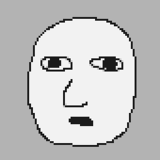2021's Best Games, Part 1: The Old Games
By PistonHyundai 0 Comments

The year is 2022, and I have successfully killed the zeitgeist. Despite AAA gaming's best efforts to make each game you play the only game you play, with their battle passes and seasonal events full of FOMO-worthy exclusive trinkets and dance animations, I find myself now more than ever playing stuff on a whim and getting to the newest games simply when I get to them, seasonal Stanky Leggs be damned. And why wouldn't I? Games drop in price faster than they ever have. Dozens are added to subscription services that seem to duplicate by the day. Epic is outright giving them away, the only price being using their terrible app. Hell, with how often they're completely busted in the weeks (Months? Years?) following release, what's the incentive in getting something at launch? Odds are, I can hold off just a few months and get a cheaper, more stable version of the game, likely with more content to boot. Plus, it's not like there was ever a shortage of games to play in the first place. Older games don't just stop existing because you haven't played them.
Maybe obtaining the hardware to do so has become a different story altogether, but it still feels like it's never been easier to play video games. If you have a capable PC and the know-how, you can play almost anything from the PlayStation 2 back, and it seems like every couple of days there's a new breakthrough that renders games once notoriously difficult to play—whether because of emulator compatibility, a language barrier, or even it never actually seeing release—now as easily accessible as MP3s became in the Napster days. It wasn't that long ago that I went and purchased a SEGA Saturn entirely because of how much of a headache emulating its games was, but now I can play nearly its entire library on the new Xbox without even modding the damn thing. That's not to say that modding is still the process it was in the days of mod chips and Pandora's Batteries, either; even tweaking your original hardware has become more viable by the day. During the Great PlayStation Store Scare of 2021, I did what any reasonable person would do in the face of countless PS3 games being lost to time and looked into modding my PS3, which was so painless (and hell, even kind of fun) that it had me looking into PS2 modding the same week, which itself has become as easy as burning a single DVD-R.
It feels like as the years go on, each wave of year-end lists has a growing number of blurbs that start off featuring some variant of "well boy, that year sure sucked shit," and yeah: fair. Contemporary life has done a pretty good job stripping most of us of our passion, but even with its own fair share of bullshit, it's still a joy to discover video games, and with the myriad options at our fingertips—whether big budget or indie, new or old—I'm inclined to believe that anyone who thinks that there aren't video games out there for them in 2022 just hasn't taken the time to find them.
That brings me to my top ten, or rather, top tens. As you may have assumed from what you just read, my year in video games was all over the god damn place, with no particular rhyme or reason to what I played beyond "well I got a Series X, I should play a bunch of Xbox games." With that in mind, I wanted to give credit to older and more recent games alike without one coming at the expense of the other, so I've put together two separate lists for both. This blog will deal with games I played that didn't come out within the past couple of years, with a more current list to follow. Anyway, enough setup: let's get to it.
#10: Vampire Savior
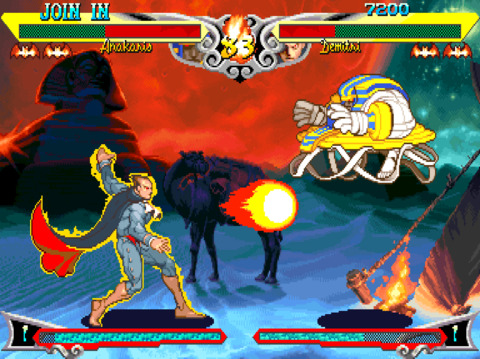
When everybody else got into woodworking or baking bread or whatever the hell it was for all of two weeks back when the pandemic first hit, I ended up getting into fighting games. Don't get me wrong, I'm not good at them, but I spent a lot of 2020 getting way better at explaining why I lost. That, and going through Tekken and Street Fighter in semi-chronological order (Tekken 3 and Street Fighter EX2 Plus are my favorites at the moment, but it seems pretty obvious that all the talk of Third Strike being the best fighting game ever is likely true from what I've played of vanilla SF3). This year, however, was where I finally started cajoling friends into online matches, and while I didn't exactly have to twist any arms, a bit of line-cutting had to occur to make that happen. As such, I can't really tell you what Vampire Savior (also known as Darkstalkers 3) has to offer over its predecessors as the third game in the Darkstalkers series. I can, however, tell you that it rules.
Vampire Savior's gameplay feels like a middle ground between traditional Street Fighter combat and the more frenzied, fast & loose action of the Marvel games. There's meters a-plenty, mid-air blocks, and each character feels like it has a repertoire of moves that'd be considered total bullshit in a traditional fighting game, but it isn't quite as broken wide open as it could be, considering the lack of Marvel's tag-team mechanic. It's nutty but manageable, and it isn't until you start to crank the turbo setting up that things really get out of control. It's a great balance of mechanics as someone who wants more hectic stuff but doesn't feel quite ready for the tag fighters, and it's simply fun as hell to play, especially when you're evenly matched with a human opponent. It also helps that the game is from when Capcom was simply at the top of their game and releasing some of the most visually stunning 2D games ever made. Their whole CPS-2 run is legendary, but Vampire Savior's dark fantasy theme really makes it stand out, with everything from the animations to the stage backgrounds having an extra polish to it. I haven't spent as much time with it as I've wanted to, but the handful of sessions I'd have are enough to earn it a spot here.
#9: Tekken 6
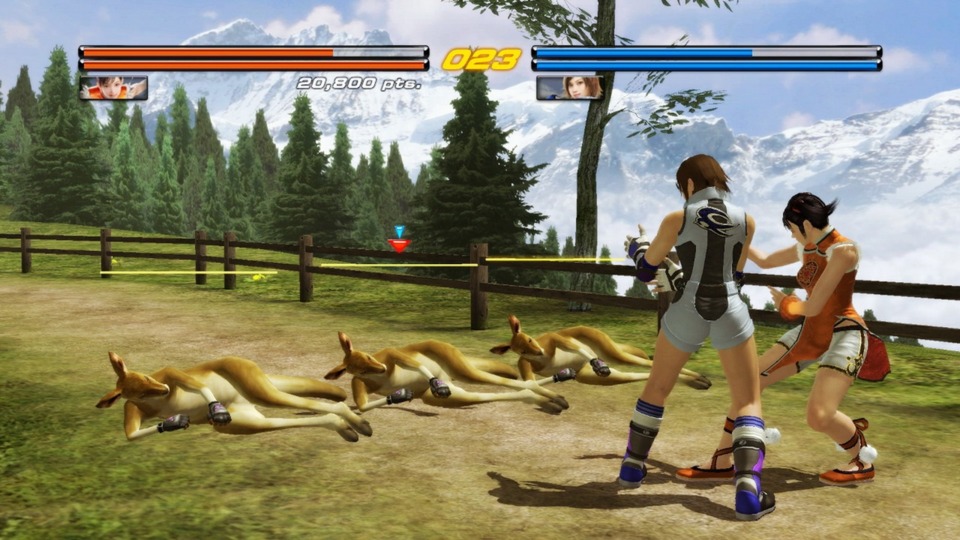
It's not all fighting games, guys, I promise.
My insistence on playing most series in chronological order almost bit me in the ass with Tekken. I had fond memories of playing 2 on a demo disc—the intro FMV was the hypest shit on Earth, and it kind of still is—but the first game really hasn't aged well, lacking the responsiveness the later Tekkens would have. Thankfully, by the time I got to 3, I was pretty into the series, and that game in particular introduced a recurring theme of Namco experimenting with their single-player component in the form of their bonus Tekken Force mode, which used the typical 3D fighting mechanics in the confines of a arcade beat-em-up. It's admittedly pretty janky, but there's a certain charm to seeing the entire Tekken roster's movelist transplanted to a neighboring genre. Being able to spam Kazuya's triple spin kick and lay waste to multiple people instead of a single person (that probably just blocked it) is a lot of fun, so I was pretty excited when I read up on Tekken 6 and saw that it finally blew up its weird beat-em-up experiment into a full-fledged campaign mode.
I'm not going to pretend like the oddly-titled Scenario Campaign mode is this brilliantly crafted experience. The story isn't particularly interesting (The Mishimas are assholes, surprise!), and its protagonist is one of the blander characters in the series. Like the Tekken Force and Devil Within modes before it, it's got a lot of the problems you'd expect a 3D beat-em-up with Tekken controls would have. It does its best to handle potential issues—you can use the analog stick for free 3D movement and the d-pad to control your character like traditional Tekken, and there's a lock-on feature to single targets out—but you never quite feel completely comfortable outside of one-on-one scenarios. Normally, this would be a disaster for a fighting game, but honestly, given the raw impact of Tekken's combat, the goofy setpieces and weapons you come across (Tekken was never big on projectiles, so adding miniguns and flamethrowers is a real treat), and the drop-based loot system that upgrades your abilities and makes your character look like a dipshit, it's a lot easier to forgive its shortcomings than you might think. It's even got online coop with a separate set of tweaked levels and excised cutscenes for a condensed, more arcade-like experience. It's especially insane with a partner, ramping up the goofier aspects poking at the edges in single-player and replacing cutscenes and any actual context for what you're doing with a greater number of violent kangaroos, aliens, sumo wrestlers, and Brazilian Carnival dancers. It's a trip.
By the time Namco released the fan-favorite Tekken 5, the series had about as good of a foundation as you could've asked for, so it makes sense that they used 6 as a chance to really spread their wings with their beat-em-up ambitions. Tekken 7 is solid in its own right, but it's the first game in 20 years to not have a Tekken Force equivalent, which makes the story mode it has in its place, which resembles Mortal Kombat's take on fighting game campaigns in what now feels like an industry standard, feel pretty underwhelming—and the less said about its Arcade Mode style endings, the better. Don't get me wrong, Tekken is defined by the richness of its combat and the sheer number of options you have in fights, but the series always went the extra mile when it came to getting weird with the extras included in their home console conversions, and Tekken 6 feels like the peak of that.
#8: Gargoyle's Quest
One of the first things I did this year was tackle the Ghosts 'n Goblins series. I honestly forget why, but the impending release of Resurrection probably had a lot to do with it. While I think the original game is legitimately bad, amounting to arcade gaming at its most cynical and transparently money-hungry, the series would find its footing immediately afterwards with the much improved Ghouls n' Ghosts, which features a level of challenge that is almost downright reasonable, especially in its US arcade release. They're all at least decent games after the first, but it's the Gargoyle's Quest spin-off series that really grabs me.

Untethered from its arcade roots and the usual GnG conventions, Gargoyle's Quest strikes a more palpable balance, slowing the pace down a bit while retaining much of its tense, exacting difficulty. Where Arthur's stiff movement and awkward attacks in Ghosts 'n Goblins proper were things you learned to deal with, Firebrand's hover and wall-jumping capabilities feel much more intuitive and satisfying. The amount of in-air control you have (which increases over the course of the game) introduces some much-needed leeway, while the level design's ample usage of ass-clenching jumps and spike walls keeps things in check, ensuring that the platforming remains as tight as it was in arcades. It isn't quite as hectic as the rapidly respawning enemies and gigantic bosses of its source material, but it curbs the frustration that can often push me away from the main series while holding onto the challenge that's so much of its appeal.
Being more of a home console style experience does lead to some shortcomings of its own, though. As the name might lead you to believe, there's a lot of RPG influence in the series, and while you don't gain experience and level up, you traverse an overworld, talk to NPCs in towns, upgrade your abilities with new equipment, and even run into random combat encounters. The upgrades lead to more interesting gameplay down the line, but the overworld stuff—particularly the backtracking it introduces and the random battles—don't really add much and feel like unneeded filler. The NES sequel nips a lot of that in the bud, but has issues of its own, thanks to a less refined sense of challenge. They're both great games, though, and I'm looking forward to getting to Demon's Crest, the acclaimed final game of the trilogy.
#7: Resident Evil 2 (1998)
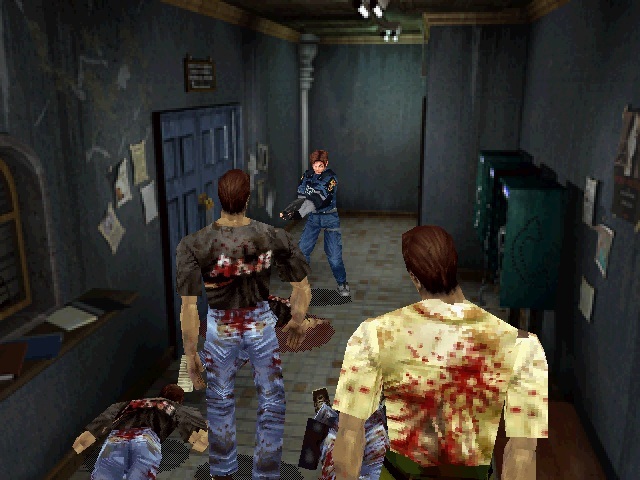
I played a hell of a lot of Resident Evil this year, going through the PlayStation trilogy, Code: Veronica, 2's remake, and even the god-awful Resident Evil: Survivor. I always had a real soft spot for the original game's campiness and its memorable setting, but it was fresher in my memory than its sequel—a game I haven't really touched since I was a kid—so I ended up being a little blown away by how much more I enjoyed revisiting RE2 this time around.
Beyond the b-movie vibes and the atmosphere of the Spencer Mansion, what really drew me into the first game was the way your experience would change depending on the character you picked. Jill Valentine had the de-facto easy mode while Chris' campaign was more strenuous, but it goes deeper than that, with setpieces, story beats, and equipment varying between the two, meaning you had to do both if you wanted the complete experience—an element that ties in perfectly with its survival horror gameplay. The first two games see you working your way around these intimate locales, redoing content somewhat regularly because of the limited save system and difficulty, so by the time you reach a second playthrough, you're well familiar with the locations and how to get around in general, letting the focus of subsequent runs be on the differences therein. RE3 and Code Veronica do away with this mechanic while also having more sprawling level design in its place, opting for singular playthroughs that are even more difficult, and I found that it doesn't really work out quite as well.
RE2 has the increased polish and refinements you would expect from a sequel, but it stands out because it capitalizes on that multiple campaign aspect like no other game in the series. The divide between Claire and Leon's loadouts is even wider than Chris and Jill's, and the unique "zapping" system (your guess on that name is as good as mine) leads to decisions in your first time around directly impacting the second, which means your resource management can end up having second playthrough ramifications, something that still feels novel today. The game's 2019 re-imagining is great in its own right, but the zapping system is MIA and the decision to bring the tenacious Mr. X to the forefront ends up feeling like a double-edged sword, as his presence in both campaigns makes your second run (where he exclusively appears in the 1998 version) feel less special.
Resident Evil 2 is a high point in the series, and there's never been a better time to play it. The fan-made Seamless HD Project uses machine learning to upscale the visuals of the GameCube port, and while it isn't quite on the level of the original game's remake, the results still speak for themselves. If you've never played the game before—and you should—this is the way to do it.
#6: Rayman 2: The Great Escape
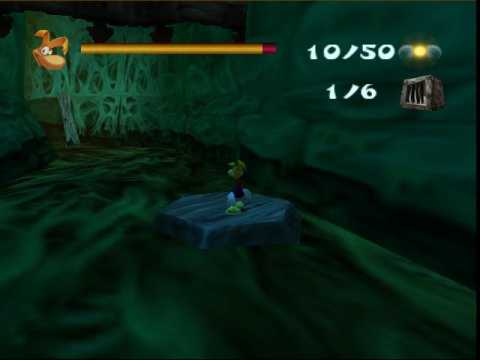
Playing Rayman 2 made me feel like a bit of a dipshit. I put it off for so long because I had assumed it was like numerous other platformers that had made the jump to 3D, ditching its linear, stage-based gameplay in favor of the more meandering non-linear stuff, and I wasn't about to deal with another Donkey Kong 64 collectathon. That, and quite frankly, I just didn't like the way it looks. The original game has some of the most beautiful and vivid pixel art of its time, and by comparison, 2's redesigned characters, kinda grungy world, and darker color palette always put me off of it.
So imagine my surprise when I finally played it this past year and discovered that it's almost exactly what you would want out of a sequel to the 1995 original. Sure, its 3D makeover still looks a little drab, and the characters are even kind of ugly, but the Great Escape realizes the potential of the original's gameplay, ironing out its punishing difficulty and cryptic collectibles while also spicing up the gameplay with some new ideas. Not all of it works out—the third-person shooting aspect of its combat wears a little thin after a while, and some late game levels get a little carried away in their gimmickry—but Rayman 2 is a great platformer that has held up considerably well. I really showed my ass passing on this for as long as I did.
#5: Descent
A few years back, a friend of mine was so adamant on me playing Descent that he zipped up his own install of it and sent it my way. Given my love of boomer shooters, having that classic Doom formula transplanted to spaceship combat was a promising idea, but I bounced off of it pretty quickly after I gave it a shot. Not because the game was bad, mind you, but a lot of its quirks just made me literally sick to play. Between grappling with the 6DoF controls and the field-of-view, motion sickness was a hurdle I just couldn't get over at the time, but I gave it another shot this year, and enough has changed since then that I was able to complete the entire game. Which I guess means I'm Rodney Dangerfield now? Is that how it works?
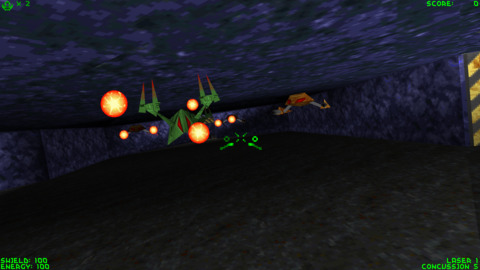
Despite its simple premise (take a space ship through mining sites throughout the solar system, rescue hostages, blow up robots, destroy the reactor, and get the hell out before the explosion takes you with it), there's a considerable learning curve to Descent, starting with figuring out a control setup that works best for you. Mouse and keyboard was the way to go for me, but it didn't go as smoothly as I had wanted in my first attempt. In Descent's original release, your ship's rotation speed was limited. It probably feels fine when using the flight sticks intended for the game, but with a mouse and keyboard setup, you would have to wait for your ship to "catch up" to your mouse's movements if you were moving it too quickly, which not only feels unnatural, but adds an overall swimmy feeling to the gameplay that makes motion sickness even worse. Thankfully, the source port I used—DXX-Rebirth, highly recommended—added uncapped ship rotation speeds since the last time I tried it, and it's a game changer, letting me really sink into the experience.
It's probably a little reductive to say, but Descent's gameplay really is classic Doom in a spaceship (right down to a lot of the enemy designs), but despite the comparisons, that extra dimension of movement really transforms the game into something unique. Gliding through mines, dancing around enemy fire, all while losing sense of which way is up (answer: it doesn't actually matter) is entrancing, and even before you consider the quality-of-life improvements introduced by source ports, it's quite effortless once you settle into the controls. For being a 1995 FPS at its core, Descent is surprisingly forward thinking: when you die, you respawn at the start of the map with only your starting equipment (similar to a Doom pistol start), but if you make it back to where you were shot down, you can recover all of your equipment—yes, kind of like souls in Dark Souls, settle down—encouraging you to be a little more reckless and play through should you die instead of just quicksaving around every corner like you might in countless other challenging shooters. There's limited lives, but an arcade scoring system lets you earn more, and point bonuses for playing on harder difficulties grant a liberating margin of error, no matter what your skill level is. At least, for the first five levels or so.

See that guy up there? That is the Class 1 Driller, and he almost ruins Descent.
When I started the game, I chose the second-hardest of five difficulties—as any self-respecting classic FPS tryhard does—and had a wonderful time for the first handful of levels. It felt surprisingly well-balanced for its age, and despite the sprawling layouts and lack of gravity, I never got lost thanks to its smart level design (keys are always collected in the same color order) and the intuitive in-game map, which is rendered in 3D similar to Doom 2016 or Metroid Prime, making it very easy to find your way. But then, the Class 1 Driller showed up and instantly cemented itself among the worst hitscan enemies in all of video games. There are other enemies that put up a hell of a fight, but they're manageable and even fun to deal with if your flying skills are up to it. The Driller, on the other hand, single-handedly throws the delicate balancing I mentioned into disarray. The second that nasty little son of a bitch sees you, you're taking damage, and if you're on a higher difficulty, half of your shields will likely be gone before it even finishes the obnoxious screech it makes when it detects you. The driller is an oppressive, exhausting presence that can be dealt with comfortably only if you know it's there ahead of time, which means that despite all of the thought that was clearly put into the challenge of the game, you're going to be quicksaving anyway to avoid cheap damage. By the time I reached the tenth of its 30 levels, I decided to switch to the second easiest difficulty for the rest of the game so I could keep playing the game the way I had before shithead showed up and spoiled my fun.
This is coming across real negative for how high up this is in my list, so I have to stress: the Driller is pretty much the only thing wrong with this game. Whenever you're not dealing with its bullshit, Descent's sensation of flight and intensity of combat is unparalleled, like the most delicious Ace Combat and Doom sandwich you can imagine. I haven't played too much of its 1996 sequel yet, but from what I've played, I'm hopeful that it'll be the improvement I want it to be. It has a "why would you do this to people" enemy of its own—a ridiculously fast robot that steals your weapons—but Rebirth has an option to remove it from the game entirely, so I'm looking forward to playing it without caveats. If it lives up to its potential, I can see it being my favorite game of 2022.
#4: Sin and Punishment: Successor of the Earth
I don't much care for 3D rail shooters when they involve moving a character or a ship around. The scripted nature stands out far more when you don't have the more hectic action of a 2D shmup or the immediacy of aiming and firing a light gun, and to me, that makes them feel like game-length versions of mediocre turret sections from a mid-2000s console shooter. Some games power through this feeling (Space Harrier and Rez come to mind), but it wasn't until I played Sin and Punishment that I really bought into the idea.
If you like retro action games, you probably like Treasure. Their games are among the most polished and exciting of their time, pushing console hardware and creativity to their limits, all while delivering action that hardly gives players time to breathe. Genre shifts, countless explosions, and intricate bosses are all common hallmarks of a Treasure game, and it's a brand of action that feels like it shouldn't even be possible on the Nintendo 64. Treasure made their name on the SEGA Genesis, something that had the processor speed to keep up with games like Gunstar Heroes and Alien Soldier, but with the following generation of hardware being the first major step into the third dimension, consoles just weren't ready for that kind of game in 3D, and this is likely why Treasure's games on that generation of hardware rely mostly on 2D assets.

Which makes it all the more impressive that Sin and Punishment is the exact kind of action game Treasure is known for, but entirely in 3D.
Yes, it only runs at 30 frames per second, but the fact that the framerate is the only compromise in achieving a 3D version of the kind of run-and-gun gameplay the studio was known for is simply astounding. Enemies are numerous (even often exploding upon death like you were playing a Contra game), bosses tower over skyscrapers, and the action only lets up once everything is dead. There's even a late-game level that shifts from on-rails action to traditional run-and-gun gameplay, as if to show that the choice of scripted movement through the levels wasn't because of system limitations.
Of course, it goes without saying that the game is a blast on top of being a technical marvel. The real difference maker here is the degree of control you have despite your movement through the levels being so scripted. Most rail shooters let you move, shoot, and maybe have a barrel roll to dodge or a smart bomb to give you a breather. In Sin and Punishment, movement feels fantastic: your double jump and dodge roll—with generous i-frames—makes weaving in and out of danger immensely satisfying, and your capabilities deliver on the offensive end as well, with parrying bullets and bombs back to enemies never growing old throughout the course of the game.
Sin and Punishment is some of the most enthralling arcade action you can get from video games, let alone the Nintendo 64. It's fairly forgiving for a Treasure game, and its pacing is practically on fast-forward, so you can knock it out in a sitting, barreling through the hilariously incomprehensible cutscenes (where English voice acting doesn't doesn't make it any less gibberish) and making it to the incredible final boss within a couple of hours. If you paid for that Switch Online Expansion Pack, play it ASAP. You'll almost feel like you weren't ripped off.
#3: WarioWare: Twisted!
One of my game-playing habits these days is using the reveal of a new game in an ongoing series as an excuse to get caught up, and that's how I got to WarioWare: Twisted last year. Of course, I didn't get to the actual new game that got released, but that might be in Get It Together's favor, since that game is going to have to pull off some real herculean shit to live up to Twisted's standard.
I've said plenty about WarioWare in the past—even on this very site—so I won't gush about the series too much here. It's been pretty consistent throughout its nearly two-decade run—with the only outright misfire being the incredibly underwhelming Game & Wario—but my favorite in the series has always been the original Mega Microgames. The others are fun, too, but some of them, like Touched and D.I.Y., feel a little too simplistic, while others (namely Smooth Moves) maybe have too much going on to aptly capture the manic action the series is known for while still feeling in control. Twisted turns out to be just right, throwing accurate motion controls into the formula without abandoning buttons entirely like the DS entries do. It hits all of those Mega Microgames notes—the quirky art direction, the breakneck pacing, the intuitive controls, the wealth of unlockable post-game content—but that extra dimension the gyroscope brings makes it all feel fresh again, allowing the experience to stand right alongside the original as one of the GBA's best.

The elephant in the room is that it's not exactly a game you can just load up in an emulator and play through, and that's really the biggest part of why it took me this long to play it. By the time Twisted was originally out, I was already playing Touched on the DS and had moved on from the GBA, so it just quietly fell off my radar despite its critical acclaim, and by the time I was interested in it again, it was off of store shelves. These days, your options are still limited, but they're out there. I originally wanted to try playing it on my phone through one of the motion-supported emulators on Android, but I don't think my phone's motion sensors wanted to play nice, so I instead moved onto using a Wii Remote, and it played pretty much perfectly. mGBA's quickly become one of the best Game Boy Advance emulators around, and its Wii release supports the gyroscope natively, making playing Twisted almost seamless. The stage themed around flipping gravity doesn't feel quite right, but it's still functional.
People often hail Twisted as the best game in the series, but I'm still a little too close to the game to make such a lofty judgement. I've been playing Mega Microgames for almost 20 years, so I'm going to need more time with the game to make that call. That being said, it's already an easy #2, being the closest Nintendo's come to capturing the magic of that first time with the original.
#2: Ape Escape
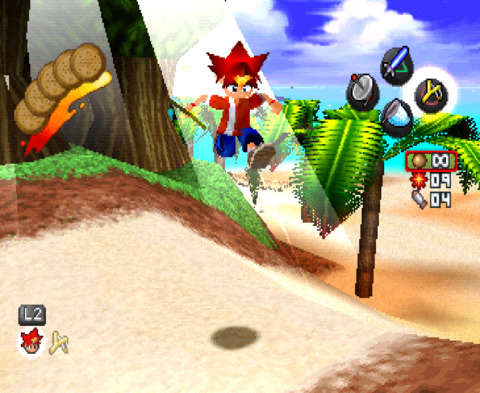
My first experience with Ape Escape was not a good one. I rented it from Blockbuster (kids, it's what your grandparents did before the existence of GameFly, which is what your parents did before the existence of Game Pass) along with a couple of other games, and quickly discovered that analog controls weren't just a recommendation. Nope, it's a full on twin-stick game—probably the only game in the entire PlayStation library that 100% needs a DualShock—so all I could do was look at the title screen before I moved onto Disney's Tarzan and Bomberman Fantasy Race. I didn't get back to it until earlier this year, when I had an epiphany: "man I should play Ape Escape." so I did. And it was good.
Ape Escape reminds me a lot of Super Mario 64. Where 64 was the big "we're using analog sticks now, motherfucker" game, Ape Escape was the first major AAA showcase for using two at a time. It was from a time before the right analog was universally relegated to being the designated camera stick (which, to be fair, is what it really should be in most cases), so Sony's Japan Studio—kids, they're who made Knack—devised a lot of novel ways to use it here. None of them represent the change in the way games are made quite like Mario's analog movement does, but they're a ton of fun regardless. Swing a net in 360 degrees to catch monkeys! Pilot an RC car! Use it in tandem with the left stick to control a rowboat (or skis)! The game is constantly introducing new gadgets and minigames that tweak the way you use the sticks, and it makes you eagerly anticipate each new level.
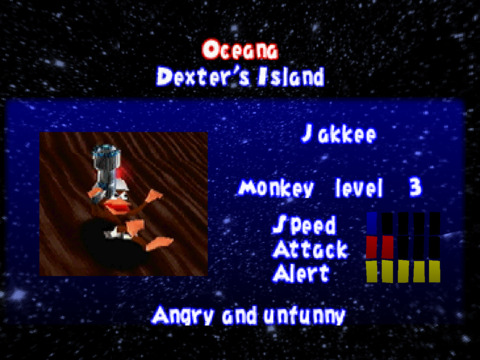
The Mario 64 comparisons don't end with the analog stick, either; the philosophy behind the level design reminds me a lot of of the game, too. Ape Escape's stages aren't these hulking behemoths like you could find at the time in Rare's N64 platformers. They feel more constrained than that, as if built with the console's limitations in mind, and it works out perfectly. One of the in-game gadgets is a radar you spin around to find the direction of nearby apes to catch, and I hardly, if ever, felt the need to use it, because the level design is so tightly designed. It's almost "linear-plus," following natural paths that splinter into additional nooks and crannies to explore, often looping back around if you go far enough. There is just enough to each level to make exploration fulfilling—especially after the credits roll, when new sets of apes are added to each stage to take advantage of your complete set of gadgets—without going too far and overwhelming you with directions to go. The perfectly-scaled playgrounds are a huge part of why I adore Super Mario 64, and I'd argue that Ape Escape may even do a better job with it, considering how gracefully it adds more collectathon-styled gameplay to the formula.
Ape Escape is one of the best games on the PlayStation. Its gameplay is engrossing, it's got a great sense of humor, and Soichi Tereda's drum-and-bass soundtrack (Get it? "Jungle?") is killer. I only wish that I had gotten to it sooner.
#1: Ganbare Goemon Kirakira Dōchū: Boku ga Dancer ni Natta Wake

Konami sure does like fucking us, don't they?
In their defense, I get why you would give up on Goemon in the West. It's almost impenetrably Japanese—especially for the localization teams of the 90s—and the games we did get (the first SNES game, one of the Game Boy releases, and two for N64) only saw modest success, but man, we didn't even get the good ones. Don't get me wrong, the Goemon games they brought over are fine for the most part, but the gulf in quality between those games and the Japan-exclusive Ganbare Goemon games feels impossible to overstate, with the fourth entry, Ganbare Goemon Kirakira Dōchū: Boku ga Dancer ni Natta Wake (or as it can be translated, "Go for it! Goemon 4: The Twinkling Journey - The Reason I Became a Dancer,") being one of the most enjoyable platformers of the 16-bit era.
Now, Harakiri Seppukumaru is an alien athlete from space (where most aliens tend to be from) who is determined to be the best at every sport in the galaxy, with his grand finale being mastering the most extreme sport of them all: seppuku, a Japanese form of ritual suicide. The important thing here is not Harakiri being oblivious to the fact that seppuku is not at all a sport (or even something you can really compete in), but the fact that Harakiri has a bomb in his stomach with the power to blow up an entire planet. This poses a significant threat to Planet Impact, the homeworld of Goemon Impact, which is Goemon's giant robot (who is revealed in the game's intro cutscene to actually be a sentient being), so it's up to Goemon and his friends to save the planet by defeating Harakiri and his minions, the Four Tsujikiri, which are aliens that look like samurai eggs, thus stopping him from destroying the planet with a seppuku-induced explosion.
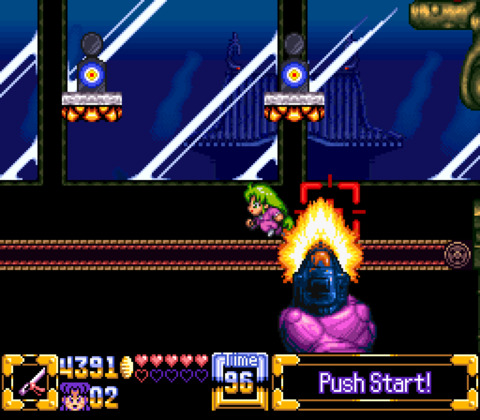
So it goes without saying that the story of the game is pretty batshit, but the gameplay is thankfully a little more grounded. Goemon games flirt a lot with Zelda-style non-linearity and exploration, and while the third Goemon game on the Super Famicom went all-in on this concept, this one is focused on traditional platforming first and foremost, downplaying a lot of the back-and-forth of the other games. The basic movement and action all feels great, and the game's structure lends plenty of variety to the gameplay. Goemon and his friends agree to split up at the start of the game, which means you play as a different character in each world, giving each segment of the game a different complexion thanks to their differing abilities. Once you complete the first four worlds, they regroup and you can freely swap between the characters in any level you've played before, letting you reach new areas and find more upgrades that can prove useful in the final set of stages. It's a fun way to break up the game, and the level design makes it easy to want to collect everything the game has to offer.
My favorite thing about Kirakira Dōchū is its sheer commitment to its bizarre theme. Keeping with the antagonist's hyper-competitive nature, sports have invaded Planet Impact, injecting the typical platformer level themes with an overdose of athleticism, leading to countless memorable setpieces. Water levels see you dodging synchronized swimmers. Instead of boulders, you outrun oversized golf balls across quicksand bunkers. A particularly inspired setpiece sees you dodging a gigantic Doom pistol while tricking it into firing at field shooting targets that will unlock the way forward. Every world is just packed with inventive tie-ins to the sport theme of the game, and seeing what the game pulls next is always a delight. Even the boss fights manage to fit in with Harakiri's generous definition of "sport," with every single encounter with the Four Tsujikiri being a different minigame, be it a Puyo Puyo-esque puzzle fighter or the most absurd practicing of Shinken Shirahadori you will ever see. Kirakira Dōchū is just seeping creativity out of every orifice, and considering how out-there the preceding games in the series were, that's a hell of an achievement.
Kirakira Dōchū is one of the finest platformers of its time, and the best game I played in 2021 that didn't come out in 2021. It's got a distinct, goofy charm only the Goemon series can bring you, and features the kind of best-in-class visuals and sound you would expect from an SNES game released late in 1995—shit, its soundtrack sounds like red book audio at times. It's a stellar game from start to finish, and I'm grateful it (along with the rest of the SNES games) finally received a fan-translation patch. It's been long overdue considering the hype that's been built up around these games, and discovering that the games lived up to it was a highlight of my year.
